Table of Contents
Introduction
According to Game-based learning Statistics, Game-Based Learning uses gaming principles that make education engaging and motivating. It involves using games, whether digital or analog, to encourage active learning, provide instant feedback, and promote problem-solving and critical thinking skills. Games cover a wide range of subjects and skills, from math to soft skills like teamwork.
They can be adapted to individual skill levels and even foster collaboration among learners. However, it’s essential to use them judiciously and align them with specific learning goals while ensuring they complement other teaching methods. Ultimately, game-based learning adds an element of fun to education, making it more enjoyable and effective for learners.
Editor’s Choice
- The game-based learning market is showing remarkable growth at a CAGR of 21.6% with its revenue projected to increase steadily over the next decade.
- In 2022, the market was valued at USD 11.5 billion, and it is expected to surge to USD 77.4 billion in 2032.
- Notably, the consumer sector commands the largest market share at 32%, reflecting the increasing trend of individuals turning to gamified educational applications and platforms to enhance their learning experiences.
- The game-based learning market exhibits varying degrees of adoption across different regions, with Western Europe leading the way, capturing a substantial market share of 47.2%.
- When it comes to game-based learning techniques, 24% of learners express a preference for activity-based gaming feeds, which offer an interactive and immersive learning experience.
- Notably, virtual reality-based learning games are leading the charge with an impressive growth rate of 51.9%, showcasing the increasing adoption of immersive technologies in education.
- According to survey data, a significant 88% of teachers who utilize digital games in their classrooms reported increased student engagement in learning, a vital factor in enhancing the educational experience.
Global Game-based Learning Market Overview
Global Game-based Learning Market Size
- The game-based learning market is showing remarkable growth at a CAGR of 21.6% with its revenue projected to increase steadily over the next decade.
- In 2022, the market was valued at USD 11.5 billion, and it is expected to surge to USD 14.0 billion in 2023.
- The momentum continues as we move into the future, with estimates of USD 16.6 billion in 2024 and USD 21.1 billion in 2025.
- Looking even further ahead, the game-based learning market is forecasted to reach USD 62.2 billion in 2031 and an impressive USD 77.4 billion in 2032.
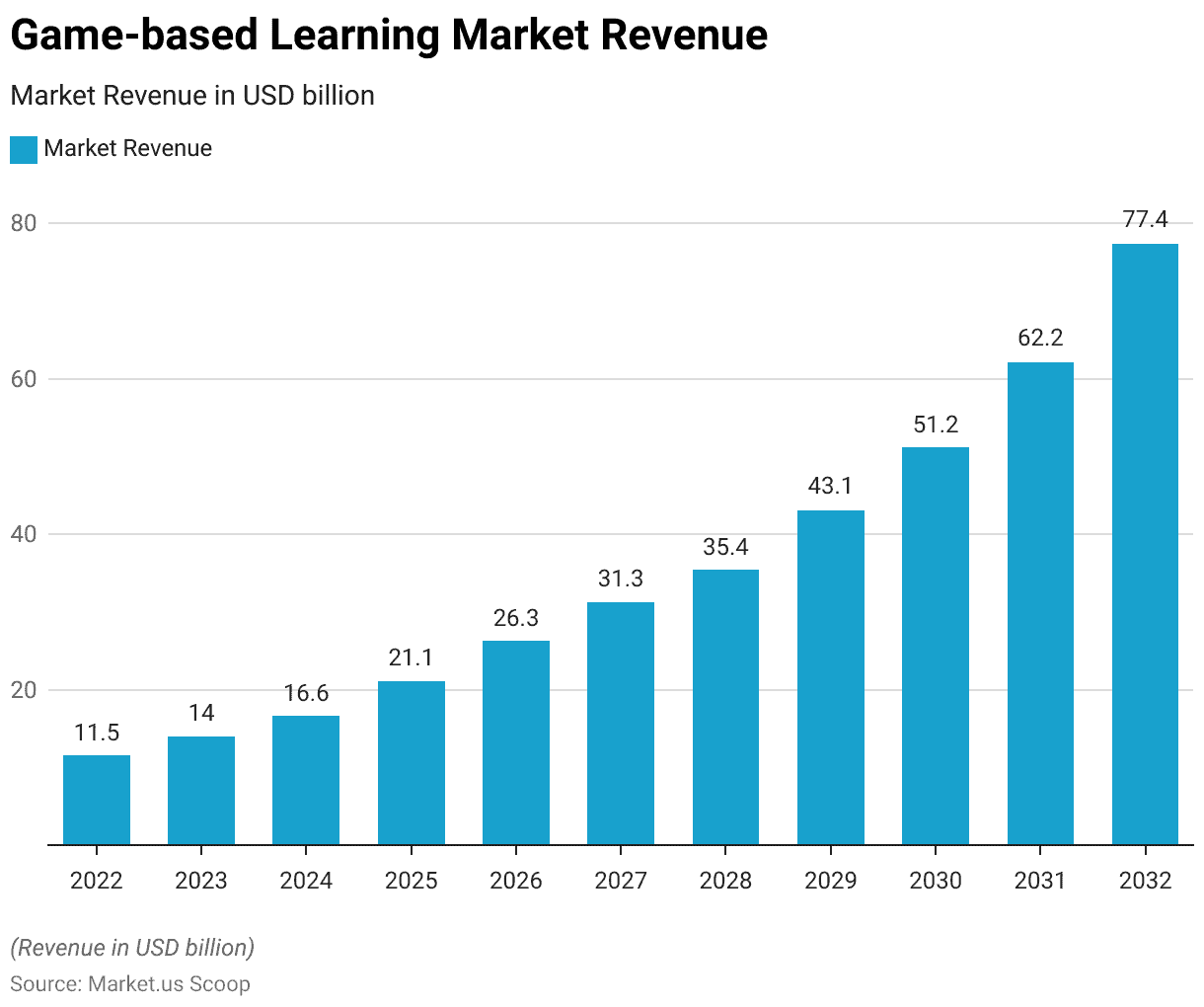
Game-based Learning Market Size – By Component
- The global game-based learning market is experiencing significant growth, with total market revenue projected to increase steadily over the coming years.
- In 2022, the market generated a total revenue of USD 11.5 billion, with solutions accounting for USD 7.0 billion and services contributing USD 5.0 billion.
- This growth trend is expected to continue, with the market revenue reaching USD 14.0 billion in 2023, USD 16.6 billion in 2024, and USD 21.1 billion in 2025.
- The rise in the adoption of game-based learning solutions is driving this expansion, as organizations recognize the effectiveness of these tools in enhancing education and training.
- By 2032, the game-based learning market is projected to reach an impressive USD 77.4 billion in total revenue, with solutions accounting for USD 45.0 billion and services generating USD 33.0 billion.
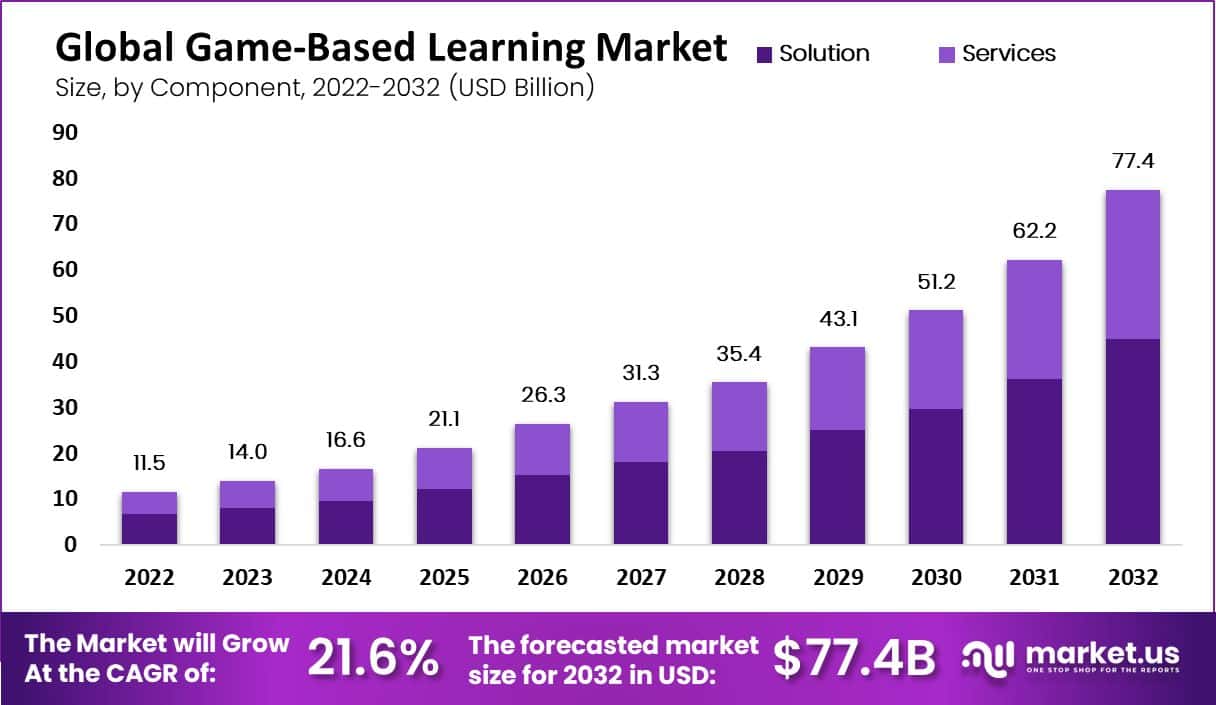
Global Game-based Learning Market Share – By End-User
- The global game-based learning market is characterized by a diverse landscape of end-user segments, each contributing to its overall dynamics.
- Notably, the consumer sector commands the largest market share at 32%, reflecting the increasing trend of individuals turning to gamified educational applications and platforms to enhance their learning experiences.
- In the education sector, game-based learning has gained significant prominence, claiming a substantial 27% market share as educational institutions and schools continue to embrace interactive gaming as a valuable teaching tool.
- Government entities, recognizing the potential of digital learning tools, contribute 11% to the market share, while enterprises, acknowledging the benefits of game-based learning for employee training and development, hold a significant 18% share.
- The remaining 12% is attributed to various other sectors, indicating the widespread adoption and versatile applications of game-based learning across multiple industries.
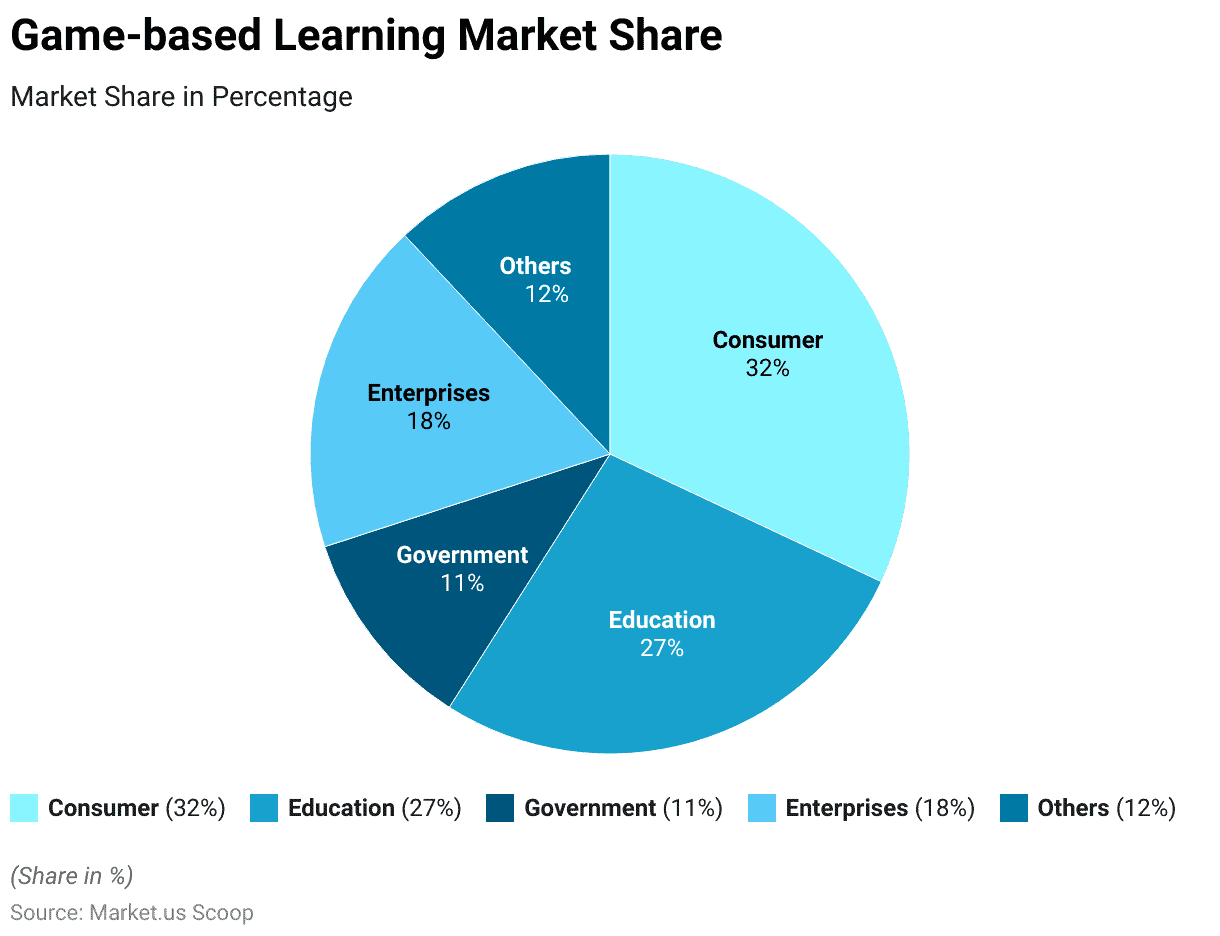
Regional Analysis of Game-based Learning Market
- The game-based learning market exhibits varying degrees of adoption across different regions, with Western Europe leading the way, capturing a substantial market share of 47.2%.
- Eastern Europe closely follows, with a significant share of 42.2%, demonstrating the growing interest in game-based educational approaches in these European regions.
- Africa and the Middle East also display strong enthusiasm for game-based learning, with market shares of 41.3% and 36.2%, respectively.
- North America and Latin America, while somewhat lower, are still actively engaging in this educational trend, contributing 35.2% and 30.1% to the market, respectively.
- In the dynamic Asia-Pacific region, game-based learning holds a market share of 27%, indicating a growing interest in leveraging gamification for education.
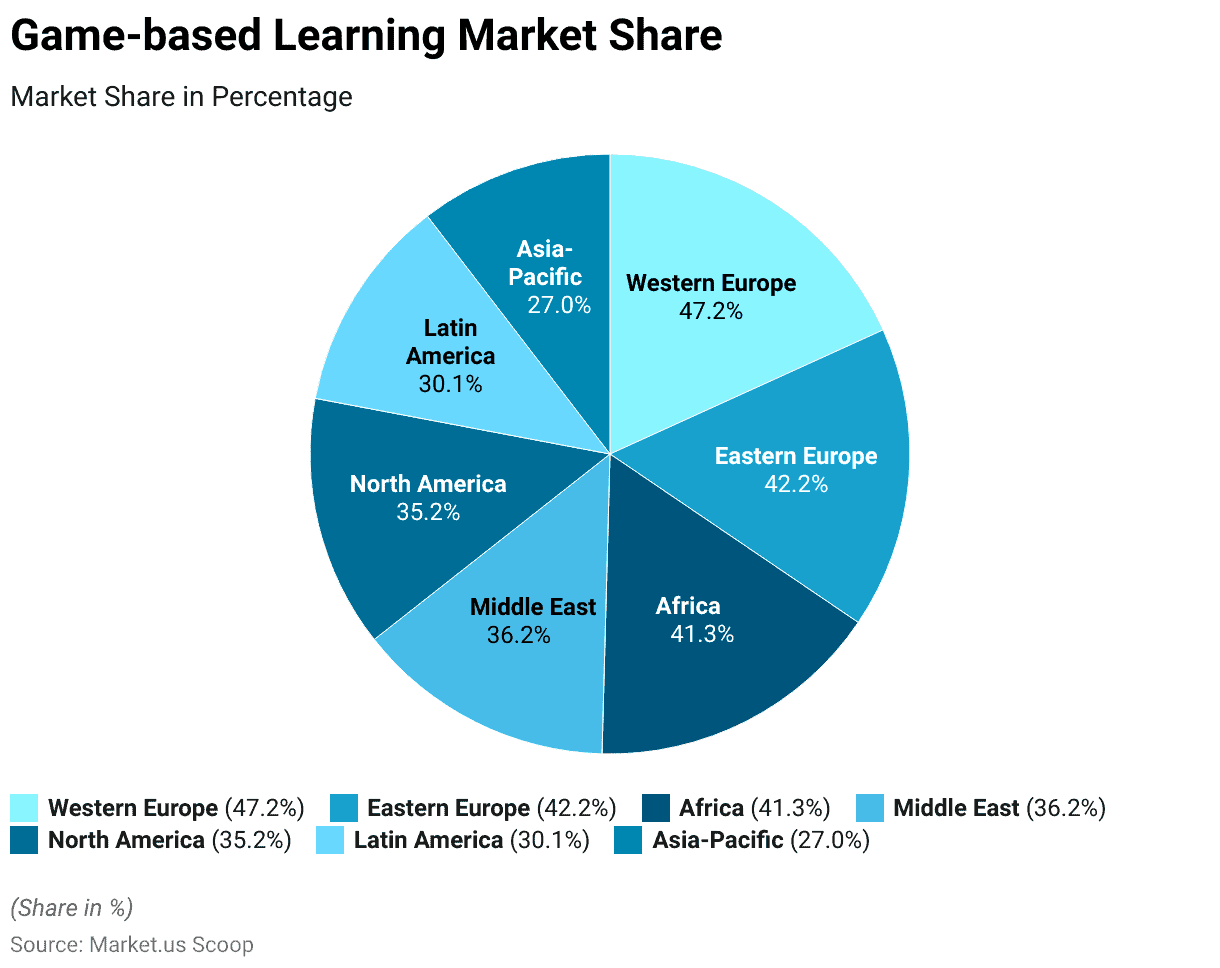
User Preferences in Game-based Learning
Most Preferred Game-Based Learning Techniques
- When it comes to game-based learning techniques, there is a notable variation in learner preferences.
- Among these techniques, 24% of learners express a preference for activity-based gaming feeds, which offer an interactive and immersive learning experience.
- Progress bars, tracking learners’ advancement, are favored by 25% of individuals, providing a sense of accomplishment and motivation.
- Instant performance feedback, with 26% of learners in favor, is highly valued for its timely guidance and assessment.
- Point scores, chosen by 27% of learners, introduce an element of competition and achievement recognition.
- The most preferred technique appears to be level-based progression, with 30% of learners opting for this structured approach that allows for gradual skill development and a sense of mastery.
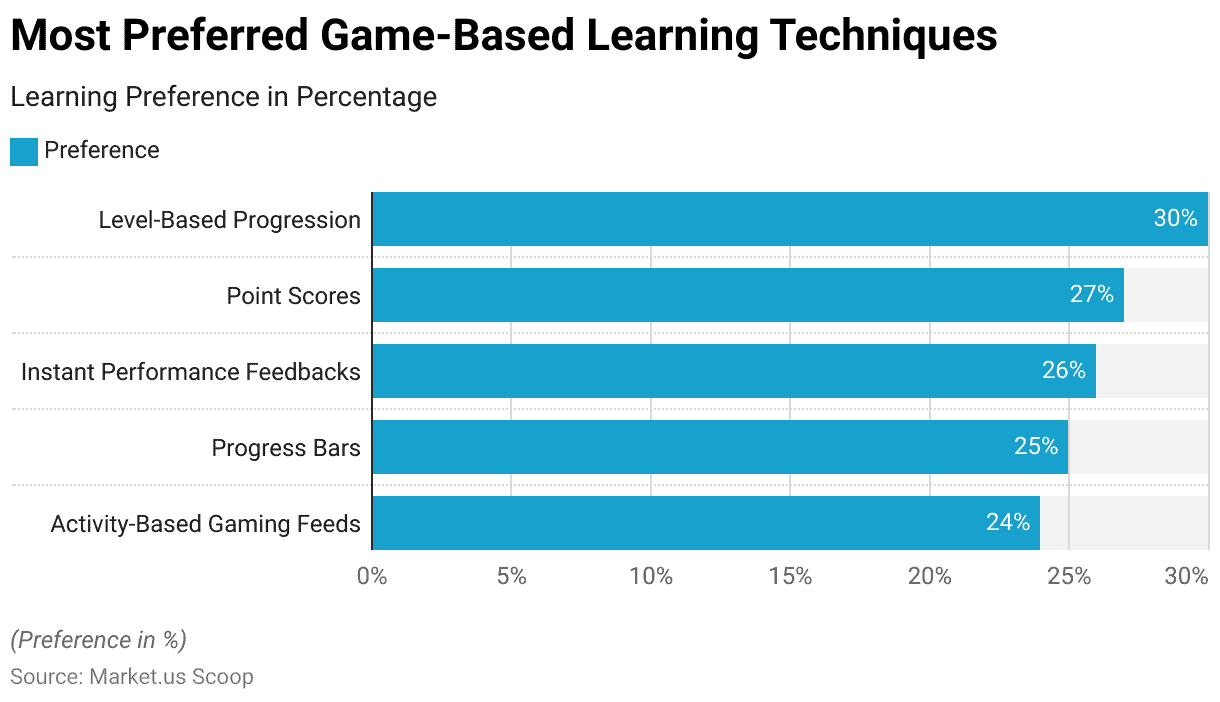
Trends Have Been Receiving a Significant Dislike from The Learners
- In the realm of game-based learning, several trends have garnered notable disapproval from learners.
- A mere 2% of users express their dissatisfaction with the use of virtual currencies, which may introduce complexities or distractions in the learning experience.
- Slightly higher, 3% oppose the presence of avatars, potentially finding them distracting or unrelated to the learning objectives.
- A more significant 11% of learners disapprove of the use of story-based scenarios, suggesting a preference for alternative teaching methods.
- Virtual gifts, disliked by 12% of users, may be perceived as extraneous or not aligned with the educational goals.
- Lastly, 13% of learners deprecate the idea of competing with friends, indicating a desire for a more individualized or collaborative learning experience.
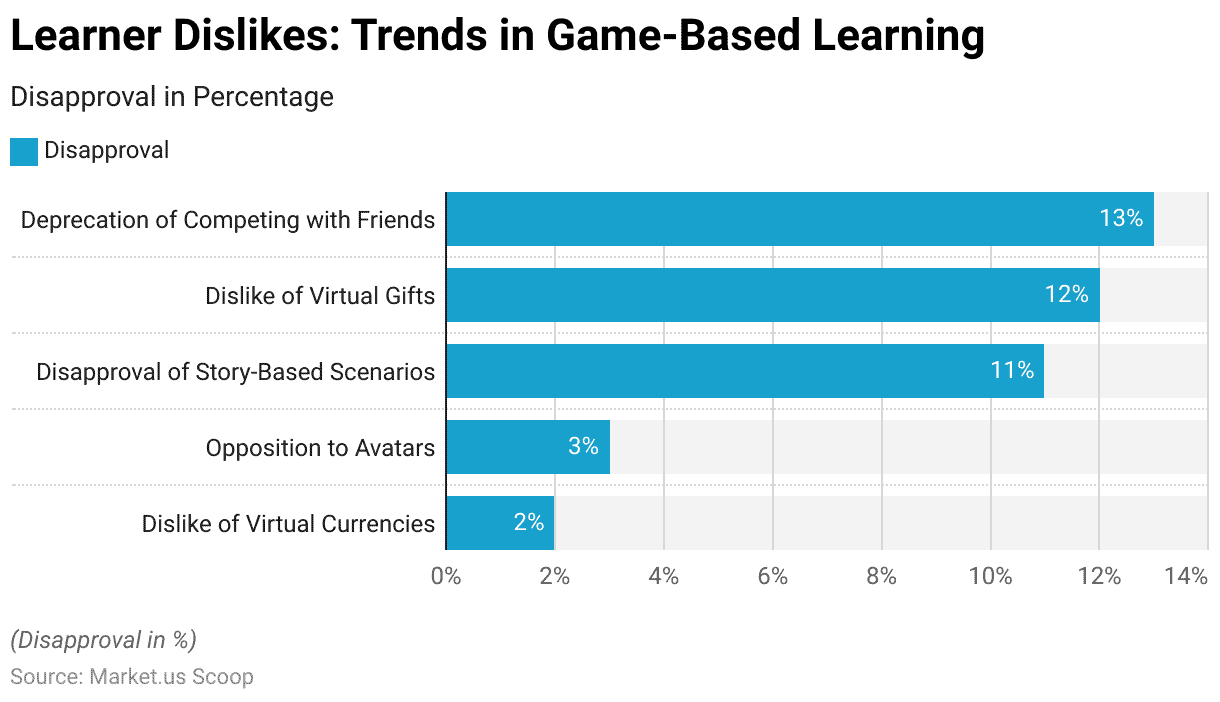
Growth Rate of Educational-type Games
- The growth rate of educational-type games reflects the evolving landscape of digital learning.
- Notably, virtual reality-based learning games are leading the charge with an impressive growth rate of 51.9%, showcasing the increasing adoption of immersive technologies in education.
- Evaluation and assessment games are also on the rise, experiencing a substantial growth rate of 46.2%, underscoring the importance of effective assessment tools in the learning process.
- Language learning games, with a growth rate of 41.8%, are another significant player, highlighting the demand for interactive language acquisition methods.
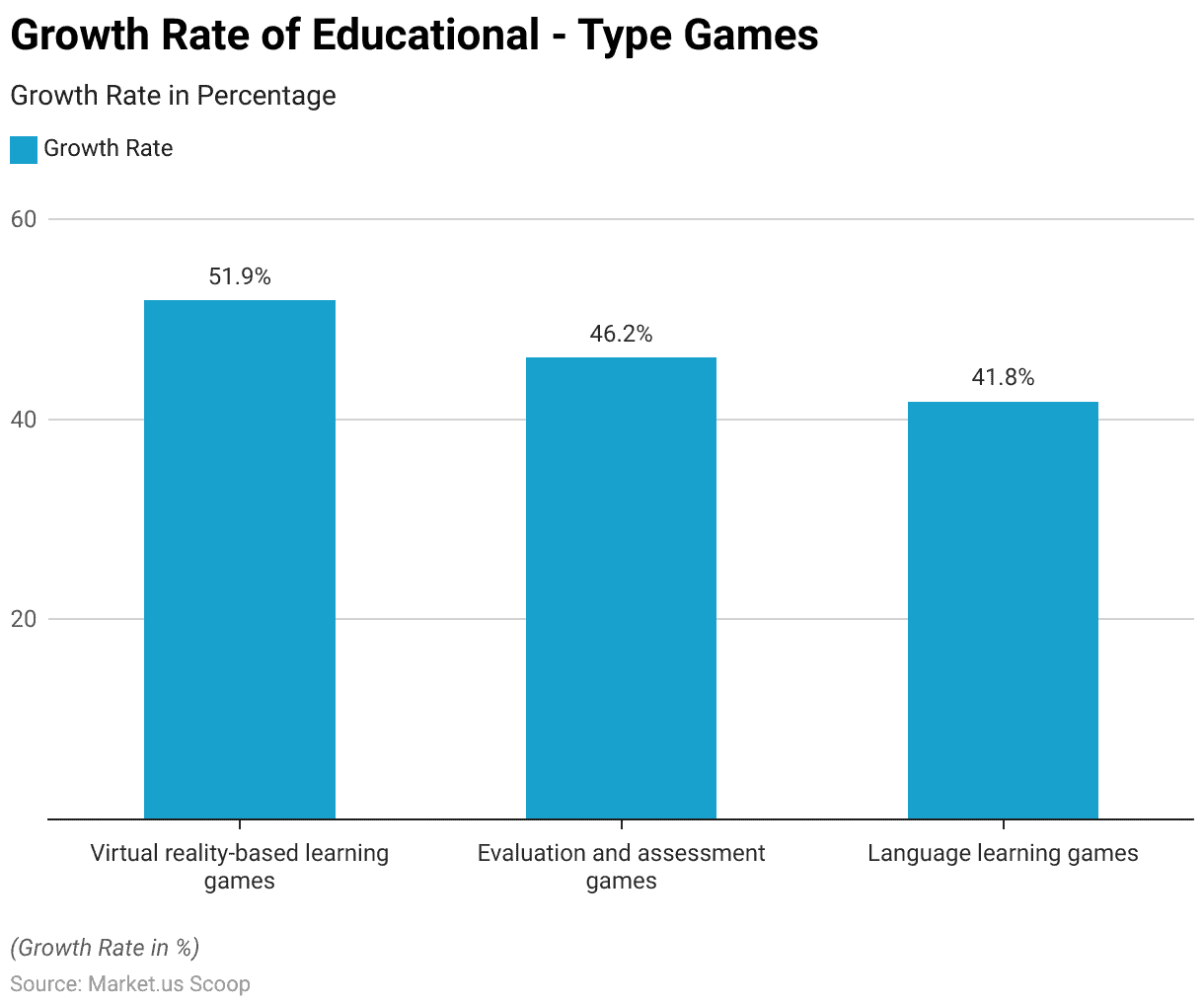
Education by Game-based Learning
- These game-based learning statistics provide valuable insights into the evolving landscape of education.
- It’s promising to see that 74% of teachers are embracing digital learning to enrich their lessons, indicating a growing recognition of its educational value.
- The fact that 93% of class time is effectively utilized during learning sessions highlights the engagement and focus it can foster among students.
- Moreover, the involvement of 52% of young students in educational games demonstrates the appeal of this approach among the next generation of learners, especially considering that 91% of school-age children are already familiar with video games.
- These statistics collectively emphasize the relevance and potential of game-based learning in modern classrooms.
- However, challenges persist, as only 46% of children have access to the necessary technology for video game-based learning, posing hurdles to its widespread implementation.
- Nonetheless, a significant 54% of U.S. educators strongly believe that game-based learning is indispensable, with an additional 38% agreeing on its necessity in the classroom.
Game-based Learning in K-12 Education
- A research study involving 105 pre-schoolers has revealed that those who were exposed to an interactive learning approach that included gestures showed improved learning performance and motor skills.
- The combined effect size for studies that integrated both online and in-person learning was +0.35, signifying a statistically significant advantage for the blended approach compared to either exclusive in-person or online learning.
- In the academic year 2015-2016, roughly 5 million K-12 students actively participated in online or virtual classes.
Game-based Learning in Work Setting
- In the workplace, the adoption of game-based learning has seen a remarkable compound annual growth rate of 53.4%. This substantial growth underscores the increasing recognition of the effectiveness of gamified approaches in enhancing employee training and development.
- Research findings have shown that the integration of micro-learning techniques has led to a significant improvement in learners’ performance, with a notable increase of 17%.
- Moreover, it has contributed to a 50% boost in engagement rates, highlighting the impact of bite-sized, focused learning modules on employee participation and knowledge retention.
Benefits of Using Digital Games Within Learning
- According to survey data, a significant 88% of teachers who utilize digital games in their classrooms reported increased student engagement in learning, a vital factor in enhancing the educational experience.
- These games also excel in addressing diverse learning styles, with 80% of these educators noting their effectiveness in catering to varied student needs.
- Additionally, they serve as valuable tools for reinforcing learning, as reported by 62% of teachers, and provide essential practice opportunities for 59% of students.
- Furthermore, digital games enable teachers to differentiate instruction, making it more personalized and effective, a feature appreciated by 59% of educators.
- These games also help students visualize complex concepts (51%) and introduce new ideas within lessons (50%), making them versatile and valuable assets in the modern educational landscape.
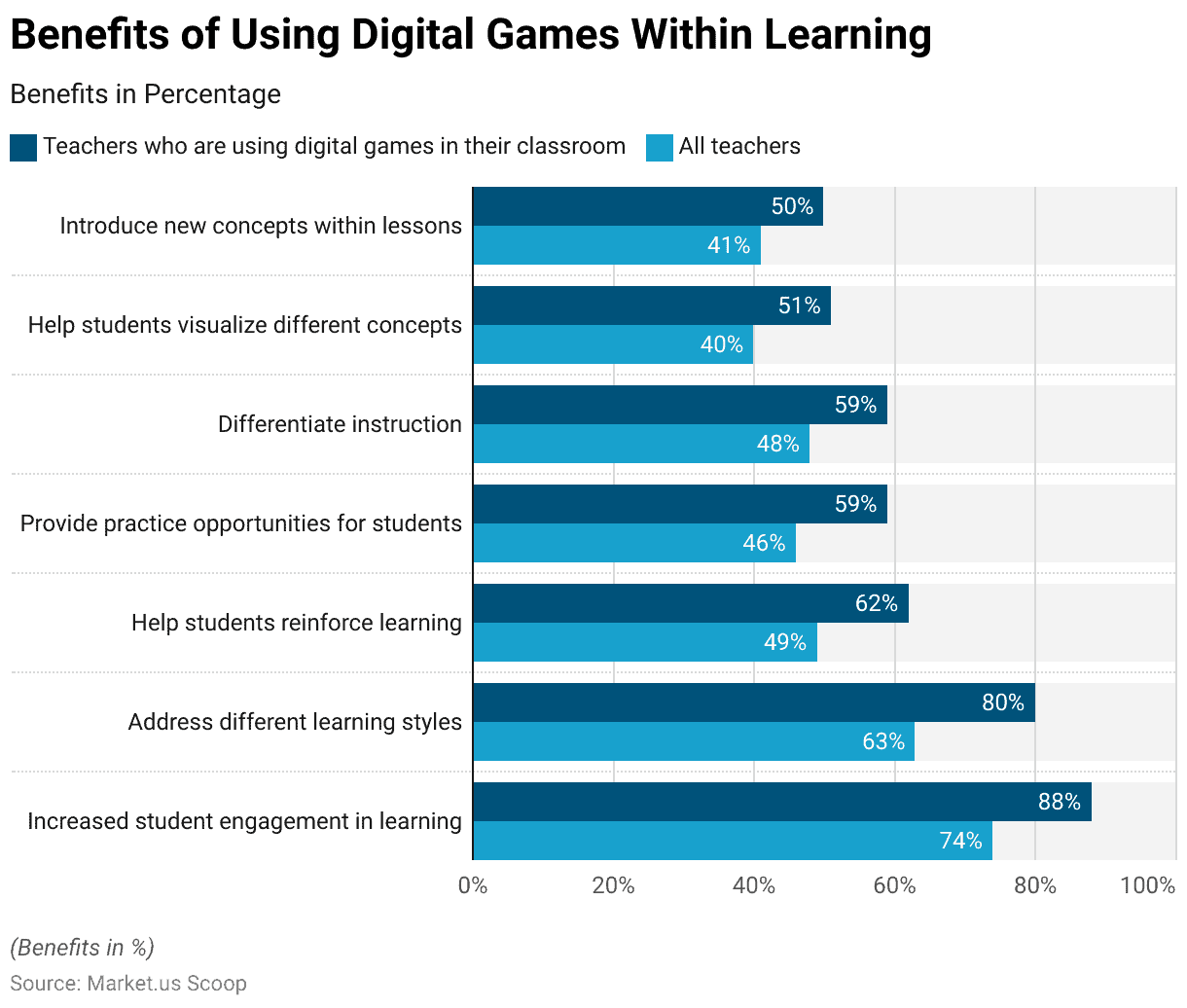
Discuss your needs with our analyst
Please share your requirements with more details so our analyst can check if they can solve your problem(s)



